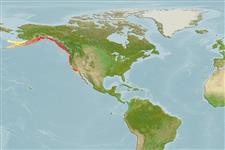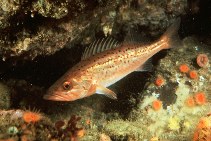Sebastes paucispinis Ayres, 1854
Bocaccio rockfish
把你的觀察加入 Fish Watcher
| Native range | All suitable habitat | Point map | Year 2050 |

|
| This map was computer-generated and has not yet been reviewed. |
| Sebastes paucispinis AquaMaps Data sources: GBIF OBIS |
上傳你的 相片 和 影像
Pictures | Google 影像Sebastes paucispinis
Picture by Gotshall, D.W.
Pictures | Google 影像Sebastes paucispinis
Picture by Gotshall, D.W.
分類 / Names 俗名 | 同種異名 | Catalog of Fishes(屬, 種) | ITIS | CoL | WoRMS | Cloffa
Teleostei > Perciformes/Scorpaenoidei (Scorpionfishes) 鮋形目 (Scorpionfishes) > Sebastidae (Rockfishes, rockcods and thornyheads) Sebastidae (Rockfishes, rockcods and thornyheads) > Sebastinae
Etymology: Sebastes: Greek, sebastes = august, venerable (Ref. 45335); paucispinis: From the Latin pauci and spinus, connoting 'few' and 'spine' (Ref. 27436).
More on author: Ayres.
Etymology: Sebastes: Greek, sebastes = august, venerable (Ref. 45335); paucispinis: From the Latin pauci and spinus, connoting 'few' and 'spine' (Ref. 27436).
More on author: Ayres.
Environment: milieu / climate zone / depth range / distribution range 生態學
海洋 礁區魚類; 深度上下限 0 - 476 m (Ref. 27437). 亞熱帶的; 65°N - 31°N
分布 國家 | FAO區域 | 生態系 | 發現紀錄 | Point map | 簡介 | Faunafri
Eastern Pacific: Stepovak Bay, Alaskan Peninsula to Punta Blanca, Baja California, Mexico.
東太平洋: Stepovak 海灣, Punta Blanca ,墨西哥的下加利福尼亞的阿拉斯加的半島。
東太平洋: Stepovak 海灣, Punta Blanca ,墨西哥的下加利福尼亞的阿拉斯加的半島。
Length at first maturity / 大小 / 重量 / 年齡
Maturity: Lm 48.0, range 36 - ? cm
Max length : 91.0 cm TL 雄魚/尚未辨別雌雄; (Ref. 2850); 最大體重: 9.6 kg (Ref. 4690); 最大年齡: 50 年 (Ref. 75794)
Max length : 91.0 cm TL 雄魚/尚未辨別雌雄; (Ref. 2850); 最大體重: 9.6 kg (Ref. 4690); 最大年齡: 50 年 (Ref. 75794)
簡短描述 檢索表 | 型態特徵 | 形態測量圖
背棘 (總數) : 13 - 15; 背的軟條 (總數) : 13 - 16; 臀棘: 3; 臀鰭軟條: 8 - 10; 脊椎骨: 26. A large rockfish with weak head spines - nasal and parietal spines usually absent, preocular, supraocular, postocular, tympanic, coronal and nuchal spines absent (Ref. 27437). Lower jaw long, thickened, with no real symphyseal knob and projects past upper jaw; maxillary extends to behind the eye; parietal ridges parallel (Ref. 27437). Caudal slightly indented (Ref. 6885). Olive orange to burnt orange or brown in color (Ref. 27437). Branchiostegal rays: 7 (Ref. 36715).
具有弱的頭部棘的一個大的礁石魚類 - 鼻骨與腔壁的棘通常不存在, preocular, 眶上的﹐眶後的﹐和鼓皮似的, 冠與頸背的棘不存在.(參考文獻 27437) 下頜長的、厚, 越過上頜沒有真正的合生癤瘤與計畫; 上頜骨延伸到眼睛後面; 腔壁的脊平行的.(參考文獻 27437) 尾部的些微地切割成鋸齒狀.(參考文獻 6885) 橄欖色橘色的到燃燒橘色或褐色顏色.(參考文獻 27437) 鰓條骨: 7.(參考文獻 36715)
具有弱的頭部棘的一個大的礁石魚類 - 鼻骨與腔壁的棘通常不存在, preocular, 眶上的﹐眶後的﹐和鼓皮似的, 冠與頸背的棘不存在.(參考文獻 27437) 下頜長的、厚, 越過上頜沒有真正的合生癤瘤與計畫; 上頜骨延伸到眼睛後面; 腔壁的脊平行的.(參考文獻 27437) 尾部的些微地切割成鋸齒狀.(參考文獻 6885) 橄欖色橘色的到燃燒橘色或褐色顏色.(參考文獻 27437) 鰓條骨: 7.(參考文獻 36715)
Adults found over rocky reefs, but also common on open bottoms to about 320 m (Ref. 2850). Juveniles are pelagic and settle in near shore nursery areas, then move to deeper habitats (Ref. 36715). Young form schools (Ref. 2850). Feed mainly on fishes, including other rockfishes (Ref. 2850). Ovoviviparous, with planktonic larvae (Ref. 36715, 6885, 34817). Validated age by radiometry is 37 yrs (Ref. 75794). A famous sport fish throughout its range (Ref. 2850). Flesh is of excellent quality when kept chilled (Ref. 27436). Sold with other rockfish species (Ref. 27436).
成魚發現在岩礁上面了, 也常見於開放的底部到大約 320 公尺.(參考文獻 2850) 稚魚是大洋性的而且停駐於近岸繁殖場, 然後移動到較深的棲息地.(參考文獻 36715) 幼魚形成魚群。 (參考文獻 2850) 主要捕食魚, 包括其他的礁石魚類。 (參考文獻 2850) 卵胎生的, 仔魚為浮游性.(參考文獻 36715,6885,34817) 在它的分佈範圍各處的一個出名的垂釣用魚.(參考文獻 2850) 當保持冷凍,肉是有優良品質的。 (參考文獻 27436) 賣與其它的礁石魚類種在一起。 (參考文獻 27436)
成魚發現在岩礁上面了, 也常見於開放的底部到大約 320 公尺.(參考文獻 2850) 稚魚是大洋性的而且停駐於近岸繁殖場, 然後移動到較深的棲息地.(參考文獻 36715) 幼魚形成魚群。 (參考文獻 2850) 主要捕食魚, 包括其他的礁石魚類。 (參考文獻 2850) 卵胎生的, 仔魚為浮游性.(參考文獻 36715,6885,34817) 在它的分佈範圍各處的一個出名的垂釣用魚.(參考文獻 2850) 當保持冷凍,肉是有優良品質的。 (參考文獻 27436) 賣與其它的礁石魚類種在一起。 (參考文獻 27436)
Life cycle and mating behavior 成熟度 | 繁殖 | 產卵場 | 卵 | 孕卵數 | 仔魚
主要參考資料
Upload your references | 參考文獻 | 合作者 | 合作者
Eschmeyer, W.N., E.S. Herald and H. Hammann, 1983. A field guide to Pacific coast fishes of North America. Boston (MA, USA): Houghton Mifflin Company. xii+336 p. (Ref. 2850)
CITES
Not Evaluated
對人類具威脅
有毒的 (Ref. 4690)
人類使用
漁業: 低經濟; 游釣魚種: 是的; 水族館: 公眾的水族館
FAO - 漁業: landings; Publication: search | FishSource | 周邊海洋
更多資訊
Population dynamics
成長參數
Max. ages / sizes
Length-weight rel.
Length-length rel.
長度-頻率
Mass conversion
入添量
豐度
成長參數
Max. ages / sizes
Length-weight rel.
Length-length rel.
長度-頻率
Mass conversion
入添量
豐度
Anatomy
鰓區
Brain
Otolith
鰓區
Brain
Otolith
Physiology
Body composition
Nutrients
耗氧量
游泳類型
游泳速度
Visual pigments
Fish sound
Diseases & Parasites
Toxicity (LC50s)
Body composition
Nutrients
耗氧量
游泳類型
游泳速度
Visual pigments
Fish sound
Diseases & Parasites
Toxicity (LC50s)
工具
Bio-Quiz | E-book | 野外調查 | 長度- 頻率 Wizard | 生活- 歷史的工具 | 分布圖 | Classification Tree
| Catch-MSY |
特別的報告
下載 XML
網路資源
AFORO (otoliths) | Aquatic Commons | BHL | Cloffa | BOLDSystems | Websites from users | 檢查 FishWatcher | CISTI | Catalog of Fishes: 屬, 種 | DiscoverLife | ECOTOX | FAO - 漁業: landings; Publication: search | Faunafri | Fishipedia | Fishtrace | GenBank: 基因組, 核甘 | GloBI | Google Books | Google Scholar | Google | IGFA World Record | MitoFish | OceanAdapt | Otolith Atlas of Taiwan Fishes | 公眾的水族館 | PubMed | Reef Life Survey | Socotra Atlas | 樹狀分類階層 | Wikipedia: 去, 搜尋 | World Records Freshwater Fishing | Zoobank | 動物學的記錄
Estimates based on models
Preferred temperature (Ref. 123201): 4.5 - 8.9, mean 5.9 °C (based on 177 cells).
Phylogenetic diversity index (Ref. 82804): PD50 = 0.5000 [Uniqueness, from 0.5 = low to 2.0 = high].
Bayesian length-weight: a=0.01000 (0.00495 - 0.02022), b=3.09 (2.92 - 3.26), in cm total length, based on LWR estimates for this Genus-body shape (Ref. 93245).
營養階層 (Ref. 69278): 3.5 ±0.46 se; based on food items.
Prior r = 0.25, 95% CL = 0.17 - 0.38, Based on 2 full stock assessments.
Fishing Vulnerability (Ref. 59153): High vulnerability (63 of 100).
Climate Vulnerability (Ref. 125649): Moderate to high vulnerability (45 of 100).
Nutrients (Ref. 124155): Calcium = 11 [4, 34] mg/100g; Iron = 0.34 [0.13, 0.81] mg/100g; Protein = 19.2 [18.0, 20.4] %; Omega3 = 0.4 [0.2, 1.0] g/100g; Selenium = 66.5 [22.9, 204.1] μg/100g; VitaminA = 52.6 [18.2, 150.1] μg/100g; Zinc = 0.446 [0.224, 0.863] mg/100g (wet weight);




